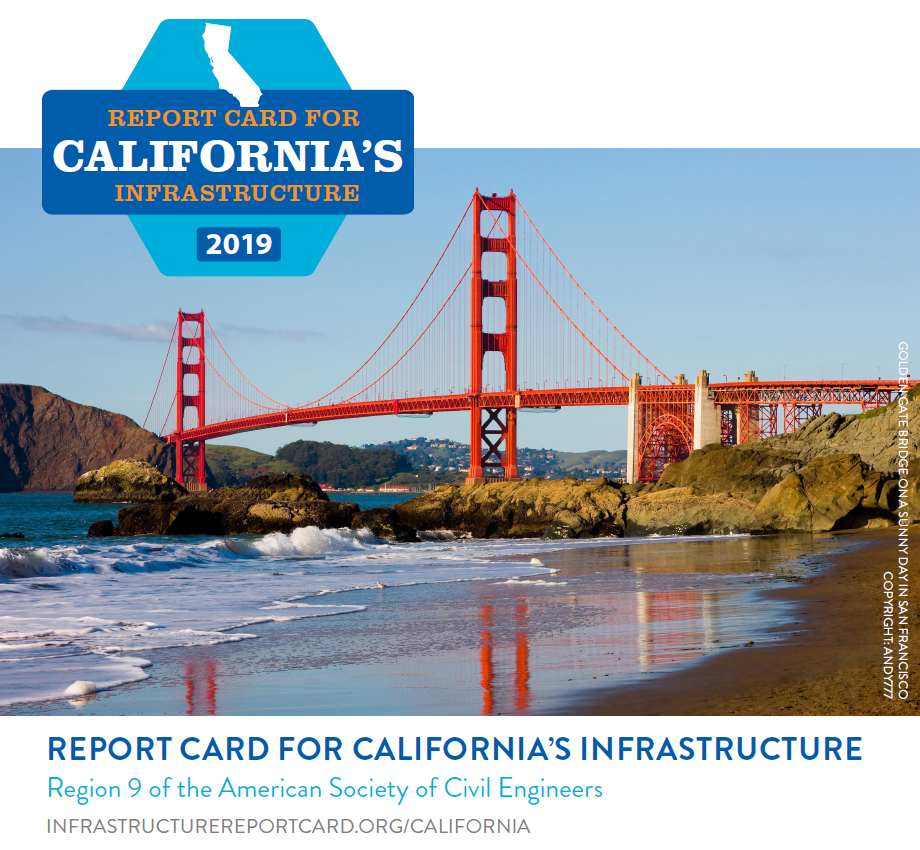Dear Friends, Family, Colleagues, and Clients:
I write now to provide an update on CDIM’s technical work over the past year supporting the American Society of Civil Engineers (ASCE) in its effort to prepare its recently released California Infrastructure Report Card. I served as the hazardous waste subcommittee chair for the 2019 report card and, along with other CDIM staff, wrote the hazardous waste section of the report.
As part of ASCE’s volunteer team, CDIM dedicated time to researching California’s infrastructure, including its condition and the economics of operation, maintenance, and capital improvement. We then assigned a grade to the infrastructure and made concrete recommendations to improve the grade.
Below I give a detailed description of our findings for the hazardous waste infrastructure (spoiler: C-) and then summarize the overall findings of the report card. I am available to discuss any aspect of the report, and I would love to talk ad nauseum with you about the hazardous waste section!
INFRASTRUCTURE REPORT CARD—HAZARDOUS WASTE SECTION
The report categorized hazardous waste (HW) infrastructure into two primary elements: HW disposal and site cleanup. Overall, we graded California’s HW infrastructure as a C-. The main reason for the low grade is that California sends around half the hazardous waste it generates to other states (or Mexico) where the waste is placed at a lower cost into non-hazardous landfills with less protective design standards (see graphic below). Another key factor for the grade is that California is not systematically evaluating the effects of sea level changes on contaminated sites that have been closed. In many of these sites, the contamination remains in place in coastal areas where both the sea level and groundwater levels are rising.
The report notes that California has developed exemplary digital tools for tracking state-wide waste disposal and cleanup (see Haz. Waste Tracking System, CalEnviroScreen, Geotrackerand Envirostor). It also notes that “Cradle to Grave” regulations for HW, and strong laws for responsible party liability in site cleanup are effective overarching frameworks that help to maintain the infrastructure and to protect California’s environment and the health of its residents.
To improve the grade, we recommend increasing funding and incentives for contaminated site cleanup (by including incentives for infill development and coastal vulnerability assessment of HW sites in a state-wide infrastructure spending plan); revamping certain programs (e.g. CLRRA, SCAP and CLEAN programs) that cause delays, confusion and poor allocation of resources; and, re-evaluating California’s HW characteristic standards, minimization programs, and landfill capacity to develop an integrated and rational statewide management strategy that prevents unnecessary disposal of waste in out-of-state/country non-HW landfills.
INFRASTRUCTURE REPORT CARD—ENTIRE REPORT CARD
It’s rare for the public to notice a well-functioning infrastructure, until something goes wrong like the Aliso Canyon gas leak or the Orville Dam spillway emergency. Only when a populated area is threatened or evacuated does the public become aware of the infrastructure's importance.
Other challenges, like bringing safe drinking water to California’s rural communities, are rarely discussed except by those who live there. In some communities, arsenic, chromium or nitrates have rendered the water unsafe and requiring treatment. And retrofitting of coastal structures for sea level rise resilience is another important part of our infrastructure that may not appear urgent in Sacramento’s myopic budget cycle. Even road improvements, which have readily visible economic benefits such as reducing vehicle wear-and-tear and increasing fuel efficiency are neglected because of inefficient resource allocation.
To assess the condition of California’s infrastructure, ASCE divided the infrastructure into 17 categories (e.g., dams, drinking water, ports, schools) and assigned a subcommittee to each category. The subcommittee did the technical research and assigned a grade. The individual category grades were then averaged by ASCE to determine the overall state grade.
The team gave the highest grades to aviation (C+), ports (C+), and wastewater (C+) and the lowest grades to energy (D-), inland waterways (D), levees (D), and roads (D).
To raise the grades, ASCE recommends that California decision-makers: 1) promote effective and collaborative leadership, 2) develop intelligent plans to better identify funding needs, 3) increase state and local funding, and 4) inform the public and raise overall awareness about infrastructure issues.
CONCLUSION
ASCE found the condition of California’s infrastructure to be inadequate. Our subcommittee found hazardous waste infrastructure to be functioning but in need of improvement, especially as relates to in-state landfill utilization, planning for more e-waste, and sea-level rise planning for contaminated sites. Because infrastructure is critical to maintaining a vital environment for citizens, business and government to function within, ASCE prepared the Report Card to raise awareness about the issue with California decision-makers and included thoughtful policy suggestions for how to make improvements. We hope that government at local, state and federal levels will take the recommendations and work to improve the grade!




